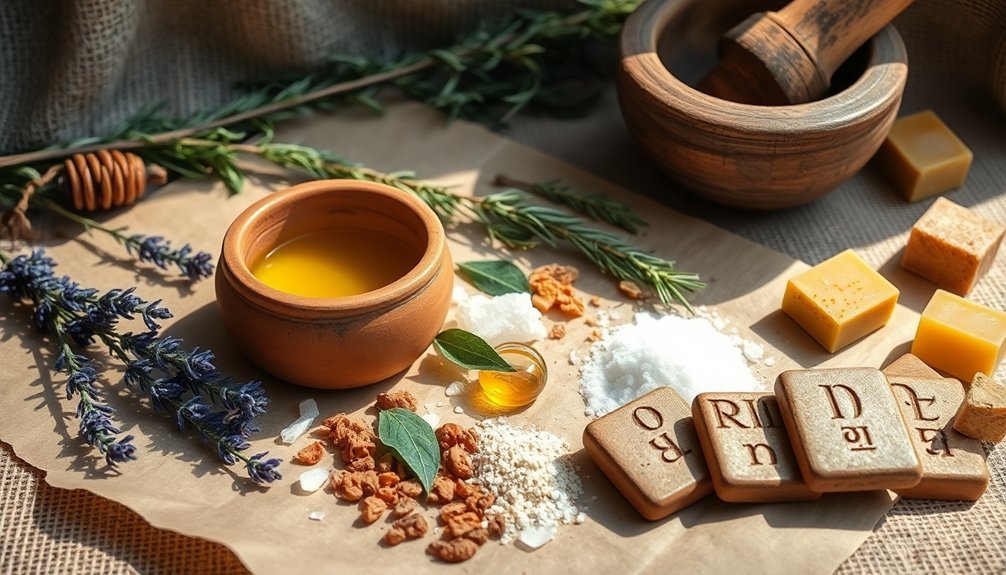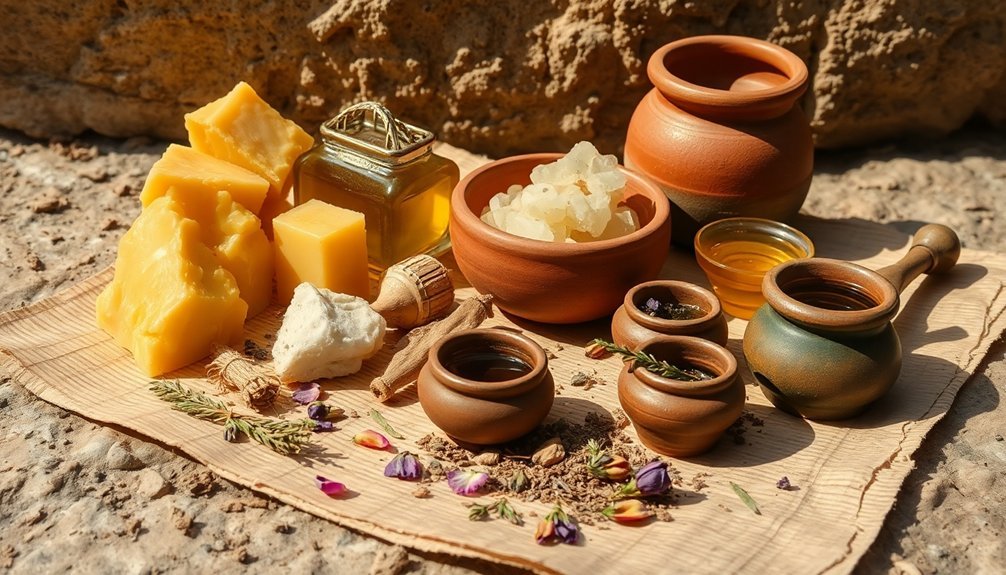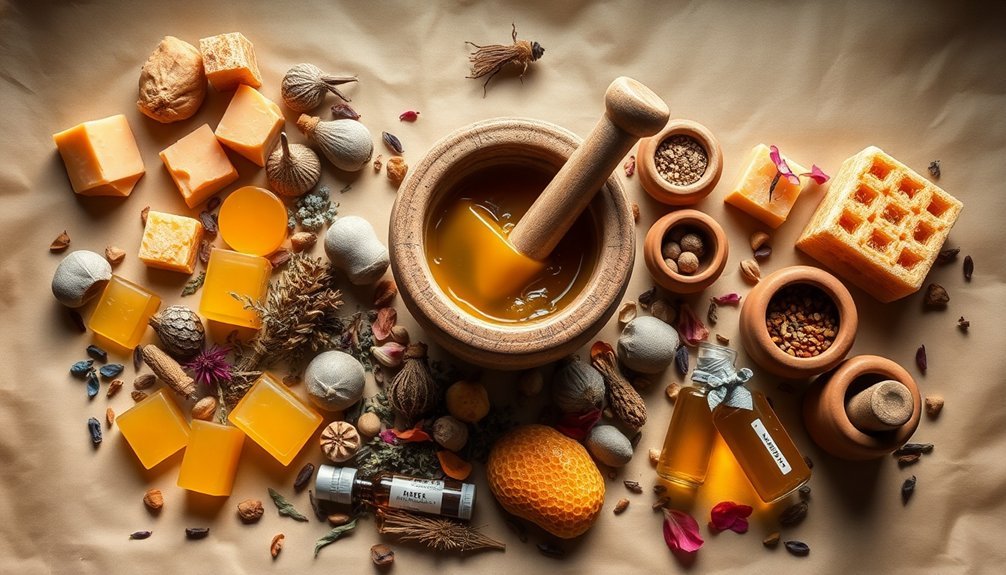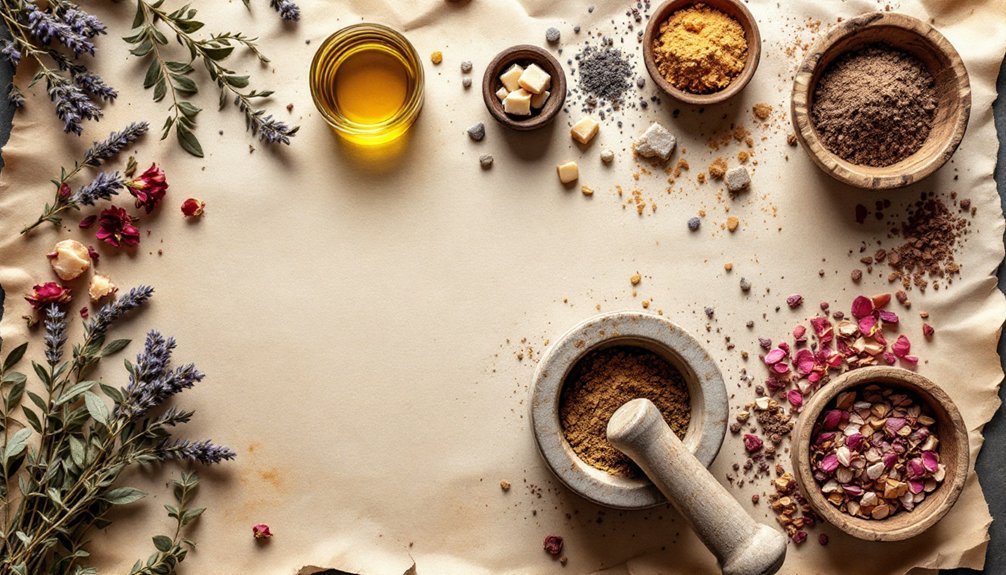Ancient civilizations created luxurious scented soaps using carefully selected raw materials. You'll find Egyptians infused their cleansers with myrrh and frankincense, while Greeks preferred olive oil enriched with sage and marjoram. Middle Eastern soap-makers elevated their craft with rose oil and saffron combinations. Romans incorporated lavender and rosemary for public baths, while Nordic traditions utilized pine and juniper. These fragrant ingredients served both practical hygiene purposes and reflected spiritual significance in their respective cultures.
Ancient Soap Scents: Raw Materials Guide From History

While modern soap-makers have endless fragrance options at their fingertips, ancient civilizations relied on locally available materials to create their cleansing scents.
The ancient Egyptians pioneered soap making around 2500 BC by combining vegetable oils with alkaline salts, then enhancing their creations with essential oils for both fragrance and medicinal properties. Their detailed recipes appear in the Ebers Papyrus from 1500 BC, showing their sophisticated approach to cleansing products.
Romans later improved these techniques by utilizing animal fats mixed with alkaline substances, often incorporating herbs and spices for scent.
Meanwhile, Babylonians focused on using animal fats and alkaline salts primarily for textile cleaning.
Essential Oils in Mesopotamian Soap Making

Although often overshadowed by Egyptian innovations, Mesopotamian soap makers developed sophisticated techniques for incorporating essential oils into their cleansing products as early as 2800 BC.
These craftspeople combined animal fats with alkaline substances, then enhanced their creations with locally sourced essential oils like myrrh and cedarwood.
When exploring Mesopotamian soap making traditions, you'll discover they valued these oils for:
- Providing pleasant fragrances that transformed basic cleansing products into luxurious experiences
- Adding potential medicinal benefits that complemented their culture's emphasis on personal hygiene
- Creating versatile formulations when mixed with honey or milk for a more soothing effect on the skin
This sophisticated approach to fragrant soap production reflects the Mesopotamians' advanced understanding of natural resources and their commitment to cleanliness in daily life.
Egyptian Fragrance Blends for Ceremonial Cleansing

The ancient Egyptians elevated fragrance in cleansing beyond Mesopotamian practices, developing sophisticated blending techniques specifically for ceremonial purposes.
They ingeniously combined vegetable oils with alkaline salts to create cleansing agents with enhanced properties and divine scents.
You'll find evidence of these practices in the Ebers Papyrus (circa 1500 BC), which details numerous fragrance blends incorporating myrrh, cedarwood, and frankincense.
These weren't merely for pleasant aromas—they carried profound spiritual significance in Egyptian culture.
During ceremonial cleansing, Egyptians anointed their bodies with these scented oils to promote purity and spiritual protection.
This integration of aromatic substances into both religious ceremonies and daily hygiene illustrates how central fragrance was to Egyptian identity and belief systems, making their cleansing rituals acts of spiritual communion.
Mediterranean Herbs as Aromatic Soap Additives

Ancient Mediterranean civilizations transformed ordinary cleansing agents into aromatic treasures by incorporating native herbs and plants into their soap-making processes.
You'll find the aromatic herbs weren't merely added for pleasant scents—they enhanced cleansing properties while providing therapeutic benefits.
- The ancient Egyptians pioneered this practice by infusing their soap-like substances with myrrh and frankincense essential oils, creating fragrant skin-care products prized for both ceremonial and daily use.
- Greeks preferred olive oil as their base, enriching it with sage and marjoram for luxurious cleansing experiences.
- Romans elevated soap crafting further, incorporating Mediterranean herbs like rosemary, thyme, and lavender into formulations used in their famous public baths.
These aromatic herbs reflected the Mediterranean cultures' understanding that effective hygiene could be both beneficial and pleasurable.
Animal-Based Scent Compounds in Ancient Formulations

While Mediterranean civilizations excelled at incorporating plant materials for fragrance, equally important were the animal-based compounds that formed both the foundation and exotic scents of early cleansing products.
You'd find animal fats like tallow serving as the primary base in soap formulations, providing essential cleansing properties through saponification.
For distinctive aromatic qualities, ancient soapmakers turned to rare animal-derived scent compounds—ambergris from sperm whales and musk from animal glands created particularly sought-after fragrances.
In Egypt, these animal components combined with floral oils created fragrant bathing experiences, while Romans enhanced their public bath soaps similarly.
These scented formulations weren't everyday items but luxury goods in personal care routines, reflecting wealth and status.
The affluent enjoyed these special fragrances during important rituals and ceremonies.
Biblical References to Fragrant Soap Materials
You'll find numerous references to aromatic materials in Biblical anointing oils, including myrrh, frankincense, and precious aloes that likely influenced ancient soap formulations.
These sacred compounds weren't merely for spiritual ceremonies but also served practical hygiene purposes in daily cleansing rituals.
The Israelites' sacred bathing traditions incorporated these fragrant oils and resins, creating a link between religious purification and physical cleanliness that shaped early soap-making practices in the Levant region.
Biblical Anointing Oils
The rich biblical tradition of anointing oils provides fascinating insights into early fragrant materials that would eventually influence soap-making throughout history. These ancient formulations combined olive oil with aromatic ingredients for both ceremonial and personal cleanliness purposes.
When you examine Exodus 30:23-25, you'll find detailed recipes that showcase the sophisticated understanding of fragrant materials:
- Myrrh and cinnamon – These premium ingredients weren't just for religious ceremonies but established fragrance profiles still valued in modern soaps.
- Calamus and cassia – These botanical additives provided both aromatic qualities and potential medicinal benefits.
- Frankincense and spikenard – Referenced throughout biblical texts including Song of Solomon, these resins added luxury to oils and early soap-like substances.
Sacred Bathing Traditions
Ancient Israelites practiced sacred bathing rituals that evolved beyond mere physical cleanliness into profound spiritual expressions. You'll find these traditions deeply rooted in Biblical texts, where sacred bathing traditions weren't just for hygiene but symbolized inner purification.
| Fragrant Material | Biblical Use | Spiritual Significance |
|---|---|---|
| Olive Oil | Anointing | Healing and blessing |
| Aromatic Herbs | Purification | Cleansing of spirit |
| Myrrh | Ritual bathing | Sacred preparation |
| Cedar | Cleansing | Strength and protection |
These materials weren't chosen randomly. The Ebers Papyrus shows similar ingredients used in Egypt, which influenced Hebrew practices. Moses's instructions connected fragrant oils to spiritual health, establishing cleanliness as a pathway to divine connection. Through these sacred bathing traditions, ancient Israelites cultivated both bodily and spiritual wellness.
Spice Trade Influence on Roman Soap Fragrances
Roman luxury bathing rituals were transformed by an influx of exotic spices that traveled thousands of miles along established trade routes to reach enthusiastic soap-makers.
The ancient Romans' fascination with scented soaps created a flourishing industry where natural oils mixed with fragrances from distant lands like India and Arabia became markers of social status.
As documented by Pliny the Elder, these aromatic additions weren't merely for pleasure but enhanced cleansing properties:
- Cinnamon – A prized spice that elevated ordinary soap to luxury status, signaling wealth and sophistication
- Frankincense – Added religious significance while providing antibacterial properties
- Myrrh – Valued for its earthy aroma and skin-healing qualities
Specialized saponarii emerged as demand grew, crafting signature blends that reflected both the expanding spice trade and Roman social hierarchy.
Perfumed Oils of the Ancient Greek Bathing Rituals
While Romans sought exotic spices from distant lands, Greeks mastered the art of perfumed oils centered around locally-sourced ingredients.
You'll find olive oil was their preferred base, to which they added essential oils from lavender, rosemary, and thyme. These aromatic substances weren't just for fragrance—they provided medicinal benefits that enhanced their bathing rituals.
Ancient Greeks believed in anointing the body before and after bathing, making perfumed oils integral to their cleanliness customs. At public baths, these scented products served as status symbols during social gatherings.
Specialized artisans known as scent makers crafted unique fragrances using techniques passed down through generations. These "scentifices" created distinctive blends that wealthy Greeks proudly displayed, demonstrating their sophistication through the complex aromas that followed them.
Celtic and Nordic Botanical Soap Ingredients
Northern Europe's soap-making traditions diverged markedly from their Mediterranean counterparts, with Celtic and Nordic peoples developing unique botanical formulations suited to their harsher climates.
You'll find these ancient cleaning agents integrated local ingredients with practical techniques for creating effective soap products.
- Native botanicals: Celts utilized yarrow, lavender, and thyme for their antiseptic properties, while Nordic soap-makers incorporated juniper and pine for enhanced cleansing effects.
- Animal and vegetable oils: Both cultures combined locally-sourced fats and oils with lye from wood ashes to trigger saponification.
- Therapeutic herbal infusions: Chamomile and nettle were steeped to create herbal infusions that imbued soaps with skin-soothing benefits.
These fragrant preparations weren't merely for cleanliness—they represented sophisticated health practices that linked personal hygiene with well-being in these ancient northern societies.
Middle Eastern Rose and Saffron Soaping Traditions
Middle Eastern soap-making traditions stand in luxurious contrast to their northern European counterparts through their use of exotic floral and spice elements.
You'll find rose oil from Rosa damascena as a cornerstone ingredient, prized for its soothing properties and distinctive fragrance that elevates personal hygiene to a sensorial experience.
Saffron, harvested from Crocus sativus flowers, appeared in formulations for wealthy patrons, contributing both its golden hue and anti-inflammatory benefits.
The combination of these fragrant ingredients with olive oil and lye created soaps that were both therapeutic and aesthetically pleasing.
The presence of rose and saffron in soap wasn't merely functional—it served as a status symbol, showcasing the owner's prosperity through these labor-intensive, costly botanicals that defined Middle Eastern soap-making as an art form.
Resinous Materials in Levantine Soap Recipes
Ancient Levantine soap artisans distinguished themselves through their masterful incorporation of aromatic tree resins, creating formulations that transcended mere cleansing to become therapeutic experiences.
You'll find these resinous materials, particularly frankincense and myrrh, were prized by ancient civilizations for their preservative qualities and medicinal properties.
When combined with olive oil and lye, these resins produced soaps with distinctive therapeutic benefits:
- Myrrh from the Commiphora tree provided soothing properties, echoing its use in Egyptian cosmetics
- Frankincense from Boswellia trees contributed healing attributes alongside its enchanting aroma
- The resin-oil combination created unique scents that reflected cultural significance of fragrance in hygiene
These aromatic additions transformed everyday cleansing into sensory rituals that connected users to ancient wisdom.
Asian Floral and Wood Elements in Early Cleansers
While Levantine soapmakers perfected resin-based formulations, their Asian counterparts developed an equally sophisticated yet distinctly different approach to scented cleansers.
You'll find that jasmine, lotus, and rose floral elements dominated ancient Asian soap-making, providing both fragrance and therapeutic skin benefits.
Wood elements like sandalwood and cedarwood were prized for their aromatic properties and became staples in traditional cleansing rituals. The essential oils extracted from these plants weren't merely for sensory pleasure—they held deep cultural significance in ceremonies across the continent.
Ancient texts reveal that combining floral and wood scents wasn't just about pleasant aromas; these blends were believed to promote relaxation and mental clarity, reflecting Asia's holistic approach to hygiene and wellness.
The sophisticated infusion techniques documented in historical writings demonstrate the advanced nature of these early cleansing practices.
Frequently Asked Questions
What Were the Ingredients in Ancient Soap?
Ancient soaps you'd use contained animal fats like tallow mixed with alkaline wood ashes. You'd find Egyptians using vegetable oils with alkaline salts, while Romans added herbs and spices for fragrance.
What Did Ancient People Use as Soap?
You'll find ancient people used animal fats mixed with alkaline salts or wood ash as soap. They'd also incorporate olive oil, vegetable oils, and fragrant additives like herbs, spices, and essential oils for cleansing.
What Are the Ingredients Used in Soap Making by the Ancient Romans?
You'll find that ancient Romans made soap using animal fats like tallow and lard, combined with wood ash for alkalinity. They'd enhance their soaps with herbs, aromatic plants, and spices for pleasant scents.
What Did the First Soap Smell Like?
You'd likely find the first soaps were mostly unscented, carrying only the natural smell of animal fats and lye. They didn't have pleasant fragrances until Egyptians started adding essential oils to mask these basic odors.
In Summary
You've now discovered the aromatic secrets that ancient soap makers treasured across civilizations. As you craft your own soaps, don't hesitate to experiment with these historical scent profiles. Whether you're drawn to Egyptian florals, Mediterranean herbs, or Eastern resins, you're connecting with traditions thousands of years old. Your modern creations can honor these ancient wisdom while bringing timeless fragrances into your daily cleansing rituals.





Leave a Reply